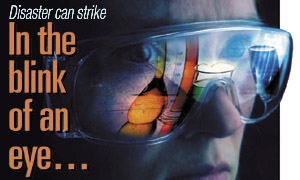
Each year, protecting eyesight on the job is a safety communication priority for about 40 percent ofISHNreaders, according to our White Paper subscriber surveys. It’s tough keeping employees interested in this kind of perennial safety topic, so here are nine nuggets to slip into your next newsletter, web posting or safety meeting.
1) Blinded by belief
There is a reason eye protection ranks with hazard communication, ergonomics and lockout-tagout as one of the most common safety training topics. Each day on the job, about 2,000 injuries to workers’ eyes occur. Of course the stakes are high: Ten percent to 20 percent of all eye injuries involve temporary or permanent disabling vision loss.
Of all the losses you attempt to prevent in safety, eye injuries are low-hanging fruit. Basic precautions can make a huge difference. Nine out of ten eye injuries can be prevented by wearing the right eyewear — spectacles, goggles, face shields, etc., according to government statistics. Regrettably, nearly 60 percent of workers who suffered injuries to the eye were not wearing any safety eyewear, according to an often-cited Bureau of Labor Statistics survey from the 1980s. Maybe that’s because they couldn’t see what was coming. Most injuries to eyes at work are caused by objects smaller than a pin head, according to employees who suffered these kinds of accidents. And most of these particles were flying at a speed faster than a hand-thrown object.
2) Don’t get side-swiped
Here’s another risk: Many of the injured workers who were wearing some sort of safety eyewear probably were not wearing side shields, according to researchers. Many times, chemicals or flying objects go around or under protective lenses to strike the eye.3) ANSI’s new standard
You should familiarize yourself and your employees with ANSI’s new standard — Z87.1 2003. One new development: There are now two levels of protection afforded by lenses: basic and high impact. Basic lenses must pass a drop ball test, where a one-inch diameter steel ball is dropped on the lens from 50 inches. High impact lenses must pass high velocity testing where one-quarter-inch steel balls are shot at varying speeds.
OSHA still requires compliance with a 1989 version of the ANSI standard that does not distinguish basic from high impact protection. Your existing inventory of safety eyewear can continue to be used. Safety distributors can give you information on new models of eye protection designed to the ANSI 2003 standard and the new marking requirements for those products.
4) “The Vision Lineâ€
Here’s a sports analogy to use with your employees to show how some of the most macho guys around are increasingly using safety eyewear, even when it’s not mandatory. Three Toronto Maple Leaf hockey players form an attack called “The Vision Line†because all three wear visors. Visor use is a growing trend in the National Hockey League.
Of course most players, like these Maple Leafs, suffer eye injuries before deciding to go with the visors. Why wait? One Maple Leaf player’s injury occurred when an opponent’s stick caught him in the right eye. There was no serious damage, luckily, but the muscles in his eye were affected to the point where they cannot keep his eyelid completely open. He even tried to tape his eye open, but it watered far too much.
5) No horsing around
Speaking of eye injuries making the news, here’s a recent story from North Carolina that shows (once more) the dangers of horseplay. In January, four teens were charged with assault with a deadly weapon after launching paintball markers from a passing car that struck a 12-year-old boy sitting on his bike. The blow left the boy blind in one eye.
Horsing around at work is so common it’s often ignored —– until something like the drive-by paintball shooting happens. You might want to tell workers to be careful with spray cans, a handy tool for horsing around. Down on the farm, spray cans are an increasing source of chemical eye injury, according to University of Maine research.
6) Lessons from the farm
Here are more lessons from farming that apply to most any workplace: Eye injuries are more likely to happen when servicing equipment, rather than operating it, according to the University of Maine research. Common hand tools can cause eye injuries, especially if they are not the right tool for the job. And when operating equipment, especially machines that chop or grind, use machine shields, wear protection and stay out of the line of fire. Make sure bystanders and passers-by keep away from the discharge path, too.
The safety message given to farmers certainly applies to your workers: Carefully select, fit and clean protective eyewear. The fit should be comfortable and snug, without interfering with movements and vision. Keep protectors in good repair.
7) Emergency response
What do you do when an eye is injured at work? First-aid is critical of course, and depends on the type of injury sustained, according to Prevent Blindness America.
In general, let natural tears wash out small specks or particles. Try not to rub the eye if possible. See a doctor if the speck does not wash out, or if pain or redness continues. For blows to the eye, apply cold compresses for 15 minutes and each hour as needed to reduce swelling. Again, if pain and swelling continues, or there is skin discoloration, see a doctor. If the eye has been cut or punctured, don’t do anything but apply a light bandage and get to a physician quickly. If an eye comes in contact with a chemical, it should be continuously flushed with water for at least 15 minutes. Don’t put anything else in the eye. See a physician and take the label or container of the chemical.